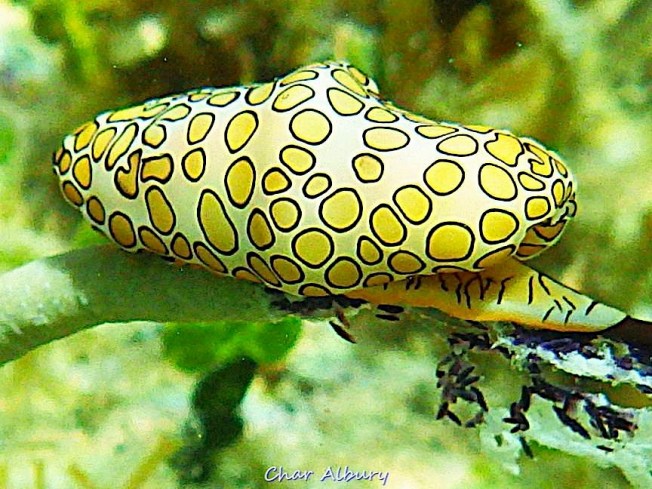FLAMINGO TONGUE SNAILS: ALL YOU NEED TO KNOW
I wrote about FLAMINGO TONGUE SNAILS Cyphoma gibbous more than two years ago. They have not changed noticeably since then but this site has – in scope, available material and audience. So I am revisiting these small marine gastropod molluscs, which are related to cowries. The live animal is brightly coloured and strikingly patterned, but that colour only exists in the ‘live’ parts – the ‘mantle’. The shell itself is usually pale and characterised by a thick ridge round the middle. These snails live in the tropical waters of the Caribbean and the wider western Atlantic. Whether alive or dead, they are gratifyingly easy to identify.
FLAMINGO TONGUE SNAIL ON A PURPLE ROPE SPONGE
FEEDING ON A CORAL STEM
This snail is snacking on a coral stem, leaving a feeding track behind it. The structural shell ridge is clearly visible beneath the distinctively marked live tissue of these creatures.
The flamingo tongue feeds by browsing on soft corals. Adult females attach eggs to coral which they have recently fed upon. About 10 days later, the larvae hatch. They eventually settle onto other gorgonian corals such as Sea Fans. Juveniles tend to live on the underside of coral branches, while adults are far more visible and mobile. Where the snail leaves a feeding scar, the corals can regrow the polyps, and therefore the snail’s feeding preference is generally not harmful to the coral.
The principal purpose of the mantle of tissue over the shell is as the creature’s breathing apparatus. The tissue absorbs oxygen and releases carbon dioxide. As I have seen it described (unkindly?) “it’s basically their lungs, stretched out over their rather boring-looking shell”.

This snail species, once common, is becoming rarer. The natural predators include Hogfish, Pufferfish and Spiny Lobsters, though the spotted mantle provides some defence by being rather unpalatable. Gorgonian corals contain natural toxins and instead of secreting these, the snail stores them. This supplements the defence provided by its APOSEMATIC COLORATION, the vivid colour and /or pattern warning sign to predators found in many species.
It comes as little surprise to learn that man is now considered to be the greatest menace to these little creatures, and the reason for their significant decline in numbers. The threat comes from snorkelers and divers who mistakenly / ignorantly think that the colour of the mantle is the shell of the animal, collect up a whole bunch from the reef, and in due course are left with… “boring-looking shells” (see photos below). Don’t be a collector; be a protector…

These photos are of flamingo tongue shells from the Delphi Club Collection. Until I read the ‘boring-looking shell’ comment, I believed everyone thought they were rather lovely… I did, anyway. You decide!
Finally, a couple of videos. The first is rather charmingly titled ‘FLAMINGO TONGUES DOING…. SOMETHING’. Any (printable but amusing) suggestions via the Comment box are welcome. The second punchily summarises this post in 30 seconds. Maybe that’s all that was needed!
Image Credits: Clark Anderson, Melinda Riger, Laszlo Ilyes, Charmaine Albury, RH
Doh! Reading through this after posting I can’t remove from my mind the likeness of Homer Simpson on the snail in Melinda’s photo (2). I had to check it out and… it’s uncanny!









Pingback: Twites, flamingoes and black swan, video | Dear Kitty. Some blog
Fascinating! At first I expected this story to lead to the surprize that someone had painted these shells and left them for someone to find. Sad as usual that man is responsible for their decline. I think the shells are also beautiful without their colourful designs; they are like beautiful rutile glazed porcelain. The Homer similarity is quite funny.
LikeLike
Hi Gina! If I hadn’t seen the shells before I saw a live FTS, I suspect I would have assumed that the shell would look like the ‘mantle’. On the other hand, I’d have left it where it was! Glad you like the shells too – and your porcelain comparison is perfect, I hadn’t thought of that. RH [Glad you liked the Homer afterthought – the similarity was haunting me…]
LikeLike